This research examined the role of emotions associated with upward social comparison processes in Korean's lives. Three emotions, i.e., buroum (benign envy), sisem (malicious envy), and jiltu (jealousy) were compared. Especially, this research focuses...
http://chineseinput.net/에서 pinyin(병음)방식으로 중국어를 변환할 수 있습니다.
변환된 중국어를 복사하여 사용하시면 됩니다.
- 中文 을 입력하시려면 zhongwen을 입력하시고 space를누르시면됩니다.
- 北京 을 입력하시려면 beijing을 입력하시고 space를 누르시면 됩니다.
부가정보
다국어 초록 (Multilingual Abstract)
This research examined the role of emotions associated with upward social comparison processes in Korean's lives. Three emotions, i.e., buroum (benign envy), sisem (malicious envy), and jiltu (jealousy) were compared. Especially, this research focuses on buroum, an equivalent to “benign envy,” and tries to demonstrate its distinct characteristics and its unique contribution to subjective well-being and psychological lives of Koreans. Compared to sisem or jiltu, buroum was found to be experienced more frequently and was perceived as more socially desirable; however, it was still negatively associated with psychological characteristics that were relevant to subjective well-being. Furthermore, examination on the perception of the comparison target indicated that buroum, compared to sisem, was directed toward someone who was close to them or whom they desired to be close. It suggests that buroum might serve a social function of managing relational harmony and strengthening social ties in interdependent culture. This research suggests to bring benign envy back into focus and emphasizes the necessity to understand the role and meanings of buroum in Koreans' affective experiences.
국문 초록 (Abstract)
이 연구는 상향 사회비교의 결과로 초래될 수 있는 정서의 하나로서 한국 문화에서 독특하게 나타나는 부러움을 조명하였다. 구체적으로 부러움은 상향 사회비교 대상에 대한 적의를 내포...
이 연구는 상향 사회비교의 결과로 초래될 수 있는 정서의 하나로서 한국 문화에서 독특하게 나타나는 부러움을 조명하였다. 구체적으로 부러움은 상향 사회비교 대상에 대한 적의를 내포하는 시샘이나 질투와는 달리 한국 사회에서 긍정적으로 인식되는 친숙한 정서이지만 궁극적으로 주관적 안녕감에 부정적인 영향을 끼칠 수 있음을 보여준다. 여기서 더 나아가 상향 사회비교를 피할 수 없는 한국 사회에서 부러움은 사회비교 대상에 대한 사회적 거리를 좁히고 조화를 유지하기 위한 사회적 기능을 수행하기 위해 발달된 정서일 가능성을 시사한다. 이를 바탕으로 이 연구는 서양문화권의 정서 연구에서 배제되었던 “무해한 선망(benign envy)”에 대한 학문적 관심을 환기하고, 한국인의 정서적 삶 전반에 있어서 부러움이 가지는 역할과 의미에 대한 연구가 필요함을 역설하고자 한다.
참고문헌 (Reference)
1 서상규, "현대 한국어의 어휘 빈도" 연세대학교 언어정보개발연구원 1998
2 안신호, "한국어 정서단어의 분석:정서단어의 유사성 구조와 정서체험의 구조" 8 : 150-175, 1994
3 한덕웅, "한국어 정서 용어들의 적절성과 경험 빈도" 19 : 63-99, 2000
4 박인조, "한국어 감정단어의 목록과 정서 차원 탐색" 한국사회및성격심리학회 19 (19): 71-100, 2005
5 한덕웅, "한국문화에서 주관안녕에 영향을 미치는 사회심리 요인들" 한국사회문제심리학회 12 (12): 45-79, 2006
6 표준국어대사전, "표준국어대사전" 국립국어원
7 안신호, "정서의 구조:한국어 정서단어 분석" 7 : 107-123, 1993
8 한덕웅, "사회비교의 목표와 성공/실패 경험에 따른 비교 대상의 선택" 13 : 311-329, 1999
9 한덕웅, "사회비교의 목표, 대상 및 성공/실패에 따른 자기 정서의 경험" 14 : 109-123, 2000
10 장은영, "사회비교의 목표, 대상 및 결과에 따른 자기정서의 경험" 한국사회및성격심리학회 18 (18): 127-153, 2004
1 서상규, "현대 한국어의 어휘 빈도" 연세대학교 언어정보개발연구원 1998
2 안신호, "한국어 정서단어의 분석:정서단어의 유사성 구조와 정서체험의 구조" 8 : 150-175, 1994
3 한덕웅, "한국어 정서 용어들의 적절성과 경험 빈도" 19 : 63-99, 2000
4 박인조, "한국어 감정단어의 목록과 정서 차원 탐색" 한국사회및성격심리학회 19 (19): 71-100, 2005
5 한덕웅, "한국문화에서 주관안녕에 영향을 미치는 사회심리 요인들" 한국사회문제심리학회 12 (12): 45-79, 2006
6 표준국어대사전, "표준국어대사전" 국립국어원
7 안신호, "정서의 구조:한국어 정서단어 분석" 7 : 107-123, 1993
8 한덕웅, "사회비교의 목표와 성공/실패 경험에 따른 비교 대상의 선택" 13 : 311-329, 1999
9 한덕웅, "사회비교의 목표, 대상 및 성공/실패에 따른 자기 정서의 경험" 14 : 109-123, 2000
10 장은영, "사회비교의 목표, 대상 및 결과에 따른 자기정서의 경험" 한국사회및성격심리학회 18 (18): 127-153, 2004
11 장은영, "사회비교의 목표, 대상 및 결과가 비교대상의 선택에 미치는 영향" 한국사회및성격심리학회 18 (18): 65-89, 2004
12 한덕웅, "사회비교가 분노경험, 주관안녕 및 건강지각에 미치는 영향" 한국건강심리학회 8 (8): 85-112, 2003
13 장은영, "비교 대상의 선택에서 환류유형, 비교속성 및 통제력의 효과" 13 : 201-217, 1999
14 Hoelzl, E, "Wearing out your shoes to prevent someone else from stepping into them:Anticipated regret and social takeover in sequential decision" 98 : 15-27, 2005
15 Dalbert, C, "The world is more just for me than generally:About the personal belief in a just world Scale’s validity" 12 : 79-98, 1999
16 Silver, M, "The social construction of envy" 8 : 313-332, 1978
17 Triandis, H. C, "The self and social behavior in differing cultural contexts" 96 : 506-520, 1989
18 Diener, E, "The satisfaction with life scale" 49 : 71-75, 1985
19 Kant, I, "The metaphysics of morals" Cambridge University Press 1797
20 Singelis, T. M, "The measurement of independent and interdependent self-construals" 20 : 580-591, 1994
21 Frijda, N. H, "The emotions" Cambridge University Press 1986
22 Parrott, W. G, "The emotional experiences of envy and jealousy in The psychology of jealousy and envy" Guilford 3-30, 1991
23 Parks, C. D, "The effects of envy on reciprocation in a social dilemma" 28 : 509-520, 2002
24 Russell, B, "The conquest of happiness" Liveright 1930
25 Foster, G. M, "The anatomy of envy:A study in symbolic behavior" 13 : 165-202, 1972
26 Duffy, M. K, "The Salieri syndrome:Consequences of envy in groups" 31 : 3-23, 2000
27 Chung, T, "Social comparison, individualism-collectivism, and Self-Esteem in China and the United States" 18 : 340-352, 1999
28 Schwartz, B, "Self-determination:The tyranny of freedom" 55 : 79-88, 2000
29 Smith, C. A, "Patterns of cognitive appraisal in emotion" 48 : 813-838, 1985
30 Schwartz, B, "Maximizing versus satisficing:Happiness is a matter of choice" 83 : 1178-1197, 2002
31 Diener, E, "Manual for the intensity and time affect survey (ITAS)" University of Illinois at Urbana-Champaign 1991
32 Van de Ven, N, "Leveling up and down:The experience of malicious and benign envy"
33 Heine, S. J, "Is there a universal need for positive self-regard?" 106 : 766-794, 1999
34 Gibbons, F. X, "Individual differences in social comparison:Development of a scale of social comparison orientation" 76 : 129-142, 1999
35 Vecchio, R, "Explorations in employee envy:Feeling envious and feeling envied" 19 : 69-81, 2005
36 Schoeck, H, "Envy:A theory of social behavior" Liberty Fund 1969
37 Beckman, S. R, "Envy, malice and Pareto efficiency:An experimental examination" 19 : 349-367, 2002
38 Smith, R. H, "Envy and jealousy:Semantic problems and experiential distinctions" 13 : 401-409, 1988
39 Lazarus, R. S, "Emotion and adaptation" Oxford University Press 1991
40 Keltner, D, "Embarrassment:Its distinct form and appeasement functions" 122 : 250-270, 1997
41 Parrott, W. G, "Distinguishing the experiences of envy and jealousy" 64 : 906-920, 1993
42 Smith, R. H, "Dispositional envy" 25 : 1007-1020, 1999
43 Lucas, R. E, "Discriminant validity of well-being measures" 71 : 616-628, 1996
44 Markus, H. R, "Culture and the self:Implications for cognition, emotion, and motivation" 98 : 224-253, 1991
45 White, K, "Culture and social comparison seeking:The role of self-motives" 31 : 232-242, 2005
46 Kitayama, S, "Cultural afffordances and emotional experience:Socially engaging and disengaging emotions in Japan and the United States" 91 : 890-903, 2000
47 Ashwin, M, "Cronos and his children envy and reparation"
48 Smith, R. H, "Comprehending envy" 133 : 46-64, 2007
49 Roseman, I. J, "Cognitive determinants of emo- tions:A structural theory in Review of personality and social psychology, Review of personality and social psychology" Sage 11-36, 1984
50 Schimmack, U, "Affect intensity:Separating intensity and frequency in repeated measured affect" 73 : 1313-1329, 1997
51 Rawls, J, "A theory of justice" Harvard University Press 1971
동일학술지(권/호) 다른 논문
-
비행청소년의 범죄유형에 따른 재범 위험성 차이에 관한 연구 -비행촉발요인 조사서와 PAI 검사결과를 중심으로-
- 한국사회및성격심리학회
- 이남희
- 2009
- KCI등재
-
Where are you from? 지역 고정관념에 따른 언어 기대 편파(LEB): 언어 범주화 모델(LCM)을 중심으로
- 한국사회및성격심리학회
- 박상희
- 2009
- KCI등재
-
역경 극복을 돕는 성인 한국인의 긍정성 탐색: 긍정적 태도 척도 개발과 타당화
- 한국사회및성격심리학회
- 현경자
- 2009
- KCI등재
-
욕구충족 및 통제감 지각이 생애후기 성인의 대인애착 성향에 미치는 영향과 애착 선행변인
- 한국사회및성격심리학회
- 이주일
- 2009
- KCI등재
분석정보
인용정보 인용지수 설명보기
학술지 이력
| 연월일 | 이력구분 | 이력상세 | 등재구분 |
|---|---|---|---|
| 2020 | 평가예정 | 계속평가 신청대상 (등재유지) | |
| 2015-01-01 | 평가 | 우수등재학술지 선정 (계속평가) | |
| 2011-01-01 | 평가 | 등재학술지 유지 (등재유지) |  |
| 2009-01-01 | 평가 | 등재학술지 유지 (등재유지) |  |
| 2007-01-01 | 평가 | 등재학술지 유지 (등재유지) |  |
| 2005-01-01 | 평가 | 등재학술지 유지 (등재유지) |  |
| 2002-01-01 | 평가 | 등재학술지 선정 (등재후보2차) |  |
| 2000-01-01 | 평가 | 등재후보학술지 선정 (신규평가) |  |
학술지 인용정보
| 기준연도 | WOS-KCI 통합IF(2년) | KCIF(2년) | KCIF(3년) |
|---|---|---|---|
| 2016 | 1.16 | 1.16 | 0.95 |
| KCIF(4년) | KCIF(5년) | 중심성지수(3년) | 즉시성지수 |
| 0.96 | 1.58 | 1.54 | 0.4 |




 KCI
KCI







